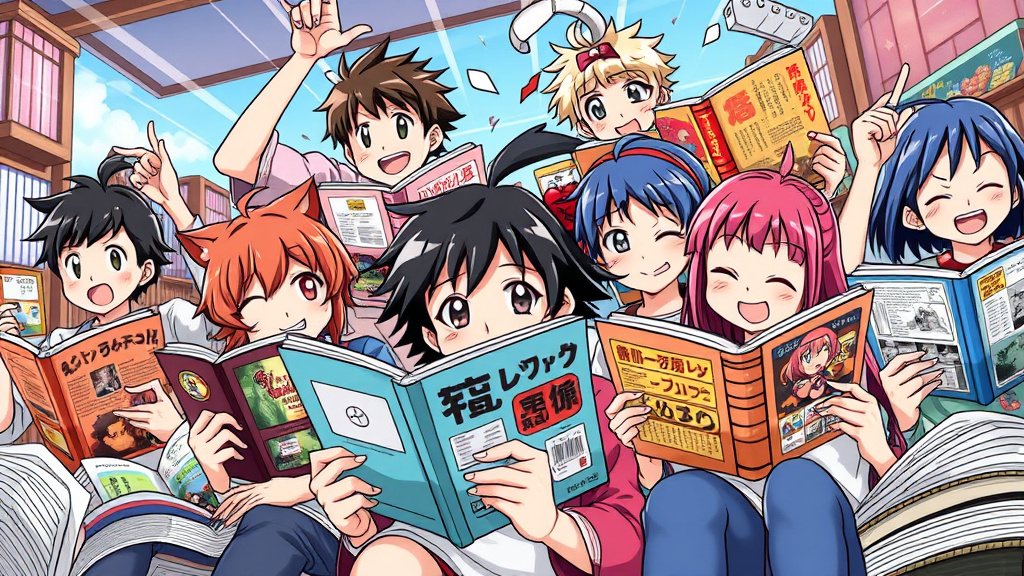english manga has become a definitive cultural phenomenon that transcends borders, appealing to a diverse and growing international audience. From local comic shops to digital streaming platforms, the reach and influence of english manga continue to expand at an unprecedented rate. This surge is not merely a reflection of Japanese culture but also an indication of how storytelling, art styles, and genre-blending resonate universally. With this rising global interest, more publishers and creators are reimagining and adapting manga for English-speaking fans, resulting in a dynamic and evolving industry that bridges cultural divides and fosters community worldwide.
The Rise of English Manga - A Growing Global Phenomenon
The proliferation of english manga signifies a significant shift in the global entertainment landscape. Historically, manga was predominantly a Japanese cultural export, enjoyed mainly within Japan and among dedicated collectors abroad. However, recent years have marked a noticeable spike in popularity, driven by digital accessibility, social media promotion, and the rise of online communities. English manga is no longer confined to original Japanese editions; it now includes a rich ecosystem of translated works, original English-produced manga, and fan-made content that speaks to the global appetite for this unique art form. This phenomenon illustrates how manga has transcended language barriers, creating a shared cultural experience that unite fans from different backgrounds.
Moreover, this surge reflects broader trends in media consumption—people are increasingly seeking diverse narratives that challenge conventions and reflect varied identities. English manga, with its ability to incorporate culturally relevant themes, modern storytelling techniques, and relatable characters, has become a vital medium for narrating contemporary issues like societal norms, mental health, and gender identity. As a result, publishers and creators recognize the importance of engaging with global markets, leading to innovative collaborations and localization strategies that boost the accessibility and appeal of manga on an international scale. The rise of english manga is, therefore, not just a market trend but a cultural shift that democratizes storytelling and broadens the horizons of comic art.
 Hình minh họa: english manga – read manhwa online app
Hình minh họa: english manga – read manhwa online appNavigating the Landscape - Key Publishers and Distributors of English Manga
The english manga industry is fragmented, with multiple publishers and distributors driving the market’s growth and diversity. Major companies like VIZ Media, Kodansha Comics, and Yen Press have established themselves as industry leaders, offering extensive catalogs that include both classic titles and new releases. These publishers not only provide licensed translations of popular Japanese manga but also produce original English-language manga tailored to domestic tastes. Their strategic marketing, digital platform investments, and licensing deals have allowed them to reach wider audiences, both through physical copies in bookstores and online direct-to-consumer sales.
In addition to these giants, smaller independent publishers and regional distributors contribute to the vibrant ecosystem, often championing niche genres or experimental works. Digital platforms such as Shonen Jump, Manga Plus, and Webtoon have revolutionized access to english manga by providing free or affordable content, making it easier for fans to discover and enjoy a vast array of titles. These platforms often operate on a subscription or ad-based revenue model, embracing technological innovation to expand reach and convenience. As a result, the landscape of english manga distribution is highly dynamic, with a mixture of traditional publishing powerhouses and innovative digital startups fueling growth and diversifying content options for international audiences.

Beyond Translation - The Art and Craft of Localizing Manga for English Audiences
Localization is an art that requires more than just translating words; it involves adapting cultural references, idioms, humor, and storytelling nuances to resonate with English-speaking readers. Effective localization preserves the original intent, tone, and emotional impact of the manga while making it accessible to a different cultural context. This process is complex because it must balance faithfulness to the source material with the sensitivities and expectations of New audiences, often necessitating creative decisions that significantly impact how the story is perceived.
Creators and localization teams must navigate linguistic challenges, cultural differences, and legal considerations, all while maintaining the integrity of the original work. For instance, translating puns or slang often requires reinterpretation rather than direct translation, taking into account cultural familiarity and humor sensibilities. This craft has evolved into a collaborative effort involving linguists, editors, and even manga artists themselves, who provide insights into cultural elements. As english manga gains prominence, the quality of localization directly influences the medium’s acceptance and credibility, making this process crucial for sustainable growth and global cultural exchange.
Genre Spotlight - Dominant and Emerging Manga Tropes in the English Market
Certain genres dominate the english manga scene, reflecting global preferences for stories that combine action, fantasy, romance, and comedy. Shonen manga, aimed at young male audiences, continues to lead the pack with titles emphasizing adventure, rivalry, and personal growth. Similarly, shojo manga, centered on romance and relationships, has carved out a dedicated fan base among young women. These genres tend to follow specific tropes—hero protagonists, transformative powers, and romantic rivalries—that appeal universally but also evolve to challenge stereotypes and include diverse representations.
Emerging tropes and genres are reshaping the market, driven by rising demand for nuanced narratives and inclusive storytelling. Webcomics and indie manga have introduced experimental formats and themes like LGBTQ+ representation, mental health, and societal critique. Genre-blending manga, combining elements of horror, science fiction, and slice-of-life, are gaining traction as creators explore more complex themes. The English market's openness to diverse storytelling reflects a maturing industry willing to challenge traditional tropes, making manga a flexible, evolving medium capable of addressing contemporary cultural conversations.
From Fan to Professional - Exploring Pathways into the English Manga Industry
The English manga industry offers diverse pathways for fans who wish to transition into professional roles. Many aspiring creators begin as passionate fans, creating fan art, fan comics, or short stories to hone their skills and build an audience. Social media platforms, webcomic hosting sites, and online forums provide accessible venues for sharing work, gaining feedback, and developing a personal style that can eventually attract publishers or crowdfunding support. This grassroots approach democratizes entry into the industry, enabling talented individuals from various backgrounds to break into professional manga creation.
Additionally, educational opportunities such as manga art courses, writing workshops, and industry internships are increasingly available, providing structured pathways for aspiring professionals. Some creators find success through self-publishing, Kickstarter campaigns, or collaborating with established publishers aiming to diversify their catalog. The growth of this industry creates a fertile environment for new talent, emphasizing not only artistic skill but also storytelling ability, marketing savvy, and cultural awareness. As the industry continues to expand globally, the line between fan and professional is becoming more fluid, encouraging innovative voices to shape the future of english manga.
The Impact of Digital Platforms on English Manga Accessibility and Consumption
Digital platforms have fundamentally transformed how english manga is accessed and consumed. Subscription services, webcomics, and official manga apps have made a vast array of titles available instantaneously at affordable prices, greatly reducing physical and geographic barriers. Platforms like Webtoon, Tapas, and Crunchyroll offer diverse content, from mainstream hits to niche indie projects, fostering a broad and engaged readership. These platforms employ intuitive interfaces, personalized recommendations, and community features such as comments and sharing tools, creating a social and interactive reading experience that adapts to modern media habits.
Beyond convenience, digital platforms enable creators to bypass traditional publishing hurdles, allowing for faster release cycles and innovative formats. Serial storytelling benefits from this immediacy, as fans can engage with ongoing plot developments regularly. They also foster active communities that support both established and emerging creators, encouraging more experimental and diverse narratives. As technology advances, the integration of augmented reality and other immersive features promises to further revolutionize language-manga consumption, positioning digital platforms as key catalysts for the ongoing proliferation and globalization of english manga.
Community and Culture - Fandoms and Engagement Around English Manga
English manga fandoms have developed into vibrant communities that foster shared interests, cultural exchange, and creative collaboration. Online forums, social media groups, and conventions serve as platforms for fans to discuss favorite series, share fan art, create fan fiction, and participate in cosplay events. This energetic engagement transforms passive consumption into active participation, empowering fans to become cultural ambassadors who promote manga within their peer groups and on a global scale.
The culture surrounding english manga is also shaped by local adaptations, such as fan translations and unofficial communities that sustain interest in titles before official releases. This grassroots enthusiasm often influences publishers to prioritize certain series or genres, shaping market trends. Moreover, these communities are increasingly inclusive, celebrating diversity and encouraging conversations about representation and social issues. As such, fandoms are more than mere spectators—they are integral to the ongoing development, localization, and acceptance of english manga, reinforcing its role as a global cultural phenomenon that bridges different identities and perspectives.
Economic Drivers - Analyzing the Market Growth and Commercial Success of English Manga
The market for english manga has experienced exponential growth, driven by multiple economic factors. The rising global middle class, increased internet penetration, and the popularity of anime adaptations have all contributed to expanding consumer bases. International licensing agreements allow publishers to tap into local markets, creating revenue streams that sustain ongoing content production. Additionally, digital sales and fan subscription models have created recurring revenue that supports both mainstream and independent creators.
Commercial success also hinges on successful marketing strategies that leverage social media influencers, anime conventions, and merchandise collaborations to boost visibility and sales. The rise of Kickstarter and crowdfunding platforms has allowed creators to gauge audience interest directly, reducing financial risks and fostering community investment. The industry’s ability to adapt to new revenue models, such as digital subscriptions, microtransactions, and print-on-demand services, ensures its resilience and continued expansion. As a result, english manga is not only a cultural export but also a lucrative economic sector with promising future growth prospects.
Challenges and Opportunities - The Future Trajectory of English Manga
Despite its thriving growth, the english manga industry faces challenges related to licensing costs, quality control, and cultural authenticity. Licensing restrictions can hinder rapid releases and availability, especially with rising concerns about piracy and unauthorized translations. Maintaining quality standards for localization remains crucial to ensuring the medium’s credibility amidst a proliferation of unofficial content and fan translations. Cultural differences, too, pose difficulties in accurately representing nuanced storytelling that resonates globally without diluting the original’s essence.
However, these challenges also present opportunities for innovation. Advances in AI translation, blockchain-based rights management, and direct publisher-to-reader models could streamline the distribution process and improve quality. Furthermore, the industry’s increasing emphasis on diverse narratives and inclusive representation opens avenues for new voices and markets. As technology and cultural sensibilities evolve, the future of english manga is poised to become more democratized, diverse, and accessible, continuing its trajectory from niche entertainment to mainstream cultural staple across the globe.
A Comparative Look - English Manga vs. Original Japanese Publications
While english manga and Japanese publications share core storytelling and artistic principles, there are notable differences rooted in cultural context and market dynamics. The original Japanese manga often reflects local societal norms, humor, and taboos, which may require adaptation to resonate with international audiences. Conversely, english manga frequently incorporates cultural references familiar to Western consumers, sometimes blending elements from both cultures to create hybrid narratives. This cross-cultural adaptation enriches the medium but also raises questions about authenticity and artistic integrity.
Moreover, the production pace, release strategies, and industry standards can differ significantly. Japanese publishers often follow a serial weekly or monthly schedule, whereas english manga may be released in bulk or serialized differently to accommodate digital consumption. Despite these differences, both formats mutually influence each other—translations introduce Japanese manga to new audiences, while successful english manga and webcomics inspire Japanese creators. This interplay fosters a vibrant, interconnected universe of storytelling where both original and localized works enhance the global cultural landscape of manga.
Conclusion
The evolution of english manga underscores a powerful cultural movement driven by digital innovation, diverse storytelling, and global community engagement. As publishers, creators, and fans navigate this expanding landscape, they collaboratively shape a future where manga is more accessible, inclusive, and reflective of contemporary societal themes. The challenges faced—in licensing, localization, and cultural adaptation—are met with resilience and ingenuity, promising continued growth and diversification. Ultimately, english manga serves as a bridge that connects Japanese narrative art with a global audience, fostering cross-cultural dialogue and shared entertainment that enriches both the industry and its worldwide fandom.





